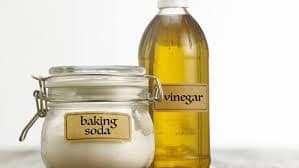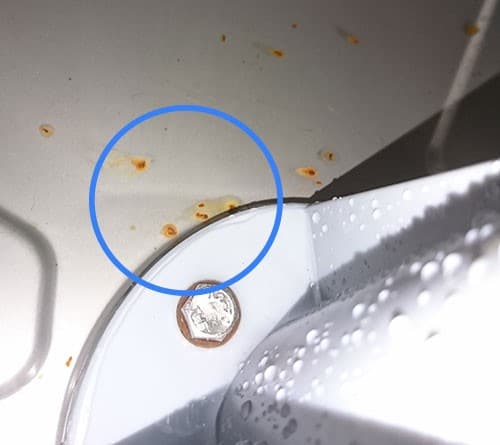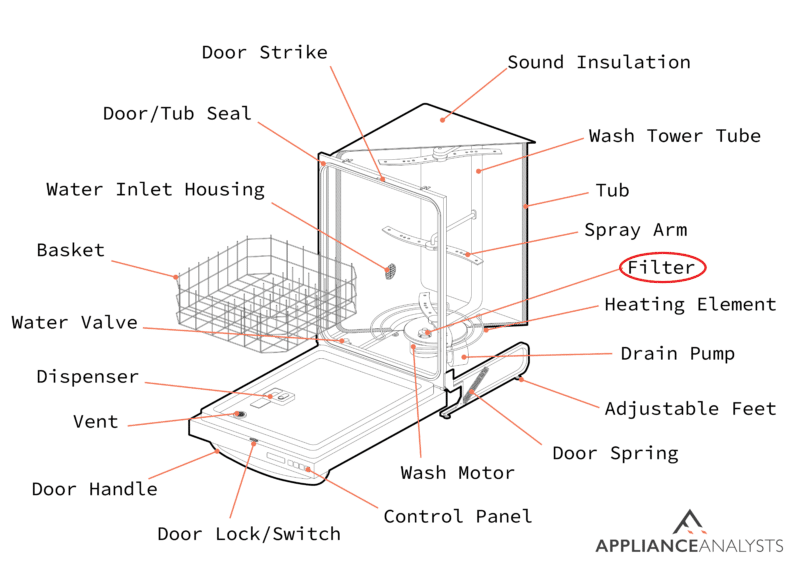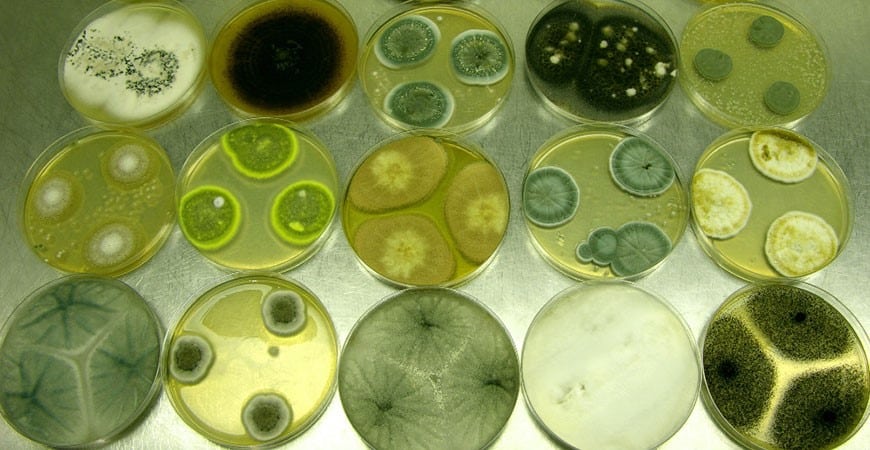We've independently reviewed this article to make sure it's as accurate as we can make it.
To find out more about our article creation and review process, check out our editorial guidelines.
Is there mold in your dishwasher?
You’re not alone. There’s nothing worse than pulling out a whole set of dishes only to find they all smell super funky.
Luckily, you’ve come to the right place to fix this issue.
To remove mold from your dishwasher, run a hot water cycle using a tablet cleaner and sanitizer. You can also use bleach or baking soda and vinegar. Remember to keep the door open after each cycle to allow moisture to escape.
Read on to find out how to clean mold out of your dishwasher for good.
Why trust us? This article was written by Craig Anderson and James Blackford. Craig has helped thousands of other homeowners repair their appliances for over 6 years. James is one of our resident appliance experts, with over 16 years of experience. He currently works as a Master Technician for SquareTrade, and runs his own appliance repair business.
How to Get Rid of Mold In Your Dishwasher: 3 Simple Ways
I know how concerning it can be to have mold in your dishwasher. After all, it can make you sick, especially if you have allergies or any respiratory condition.
Don’t worry, though. There are simple ways to eliminate mold and keep you and your family safe. These are:
#1 Use Cleaning Tablets and Sanitizer
In my experience, removing mold from your dishwasher can be easily done by using a cleaning tablets and running a cleaning cycle (while empty).
Make sure to clear and clean your dishwasher’s filter before you do this. We want to ensure good water flow.
It’s essential to clean your garbage disposal with a foaming tablet cleaner as well. Since dishwashers and garbage disposals are typically connected through the same system, cleaning both appliances will help prevent unpleasant odors.
Then, keep the door open to allow air to circulate and help moisture evaporate, allowing your dishwasher to dry. This will prevent mold from reappearing in your dishwasher.
It’s worth noting that some dishwashers retain more water than others, making them a bit smellier compared to higher-end models.
#2 Use Bleach
There’s an additional mold removal method for your dishwasher you can try for quicker results.
Note – Don’t use bleach if your dishwasher has a stainless steel interior. It can damage and mark it! Normal dishwasher metal is completely fine, though.
Dilute one cup of bleach in a gallon of water and scrub the inside of the dishwasher with a stiff brush. Use an old toothbrush to scrub into any nooks and crannies in the machine. When you’re done, run the machine empty for one cycle to rinse any bleach residue.
Chlorine bleach can easily kill mold and remove mildew stains. However, opening the windows and using protective gear to protect your skin and eyes is important.
You should NEVER mix bleach with ammonia or acid products, such as vinegar. Mixing these cleaners can create toxic fumes that can be harmful to your health. Additionally, you should never use bleach in stainless steel dishwashers, as it can damage the steel.
Remember, once you’ve finished the cycle to rinse, leave the machine door open fully to allow the inside to dry out thoroughly. You can help dry out puddles or damp areas with a clean, dry cloth.
#3 Use Baking Soda and Vinegar
If you prefer a natural cleaner to remove mold from your dishwasher, or you have a stainless steel model, you can use baking soda and vinegar instead.
Pro – tip: Baking soda and Bicarbonate of Soda is exactly the same thing!

In my experience, it’s best to use baking soda and vinegar separately rather than mixed together.
Please follow this cleaning method to get rid of mold in your dishwasher:
- Sprinkle a cup of baking soda at the bottom of your dishwasher and let it sit overnight. This will help get rid of the musty odor.
- Place a cup of vinegar on the top rack of your dishwasher and run a cycle with the hottest water settings. This will clean and sanitize your appliance.
- If your dishwasher smells like vinegar, run an additional cycle with hot water to rinse out any residue.
Once you’re done with those steps, open the machine door and leave it open so it can dry out fully.
Preventing Mold In Your Dishwasher
To prevent mold in your dishwasher, it’s crucial to understand how mold grows.
Mold spores are always present in the air around us. However, they only grow and reproduce under specific conditions: warm, dark, moist environments rich in organic material, such as food debris.
Now, imagine your dishwasher. After a wash cycle, it’s warm and damp, and there might be bits of food left behind. This creates the perfect environment for mold to thrive.
So, how can you prevent mold from growing in your dishwasher? The answer lies in regular maintenance and frequent cleaning.
One of the most important mold prevention methods is to leave the dishwasher door open when not in use and keep the windows open to ensure proper ventilation!
This is ESPECIALLY true on higher-end dishwashers, specifically on Samsung dishwashers. These models seal exceptionally well, so a closed door means a dark box full of moist air. In other words, mold paradise.
In addition to keeping the dishwasher door open, follow these simple tips to prevent mold:
- Always clean up visible food bits left in your dishwasher with paper towels and mild detergent, as mold can easily grow in environments with organic material it can consume. It’s also important to clean your dishwasher with tablet cleaners once a month.
- Clean your dishwasher’s accessories and parts. In my experience, proper cleaning can reduce excess moisture and kill any mold spores that might be present in your dishwasher. So, make sure to follow these steps:
- Take out any removable racks and the utensils’ holder.
- Clean off any food debris with paper towels or a damp cloth.
- Using an all-purpose cleaner, wipe down and disinfect the parts.
- Use a toothbrush or soft scrubbing brush to clean the spray arm – this will eliminate any clogs that are stopping the machine from cleaning effectively. You can also use vinegar to break down any stubborn buildup and kill mold.
- Clean the dishwasher filter. You can check your manufacturer’s manual, but typically you can take the filter out and run it under hot running water to dislodge dirt and food particles. I recommend using soapy water and a wire or hard nylon brush to clean the dishwasher filter.
- Remove rust stains from your dishwasher. Rust stains can encourage mold growth, so remove them too by adding a cleaning product designed to remove rust into the machine’s soap dispenser drawer/cup. Also, sprinkle a thick layer of the same rust remover over the bottom of the dishwasher (inside). Then, run the empty dishwasher through a complete cycle and allow drying well afterward.

- Clean your dishwasher’s door effectively to prevent mold by opening it wide to get into the top, bottom, and sides. With an old toothbrush and a gentle cleaning agent that’s safe for the finish of your appliance, gently scrub in and all around the door with hot water. Make sure you get fully into all the grooves and crevices of the door!
- Keep the door seals/gaskets clean. This means cleaning them now and again. You can do this by taking a damp cloth and wiping them out with hot soapy water or vinegar. When they’re spotless, and you’ve tackled all those hard–to–reach bits, dry them thoroughly with a dry rag or cloth to prevent future mold growth.
- Properly load your dishwasher. Ensure your dishes are not touching each other to allow better air circulation, which is essential to prevent mold growth. I also recommend facing your dishes toward the center and placing large items at the back.
- Regularly inspect your dishwasher: Inspect the interior walls, spray arms, door seal, filter, and drain once a month to ensure they’re not damaged or dirty. This quick action will help you catch any potential problems early and prevent mold growth in your dishwasher.

FAQ
What Is Mold?
Simply put, mold is a type of fungus that can easily grow in damp and dark environments, like your dishwasher. It grows in multicellular filaments (or strings) called hyphae.
It’s those fuzzy and thread-like bits that give mold its weird and wonderful looks, and because there are many different types of fungi, it can take on a number of forms.
Below are some examples of mold growing in petri dishes.

Mold grows from spores floating around in the air, so no home is immune from its presence.
Although mold causes household damage and food spoilage, it is important for making tasty things like cheese, but they are also used to make the antibiotics that fight off disease when we’re ill.
Signs of Mold in Your Dishwasher
Often, you may have mold in your dishwasher and not even be aware of it – many forms of mold are tiny, and some kinds can be colorless, so they can be very hard to spot.
To be on the safe side, it’s best to assume that you do have mold in some crevices of your dishwasher – that may not even be obvious to the naked eye.
That being said, one of the most obvious signs of mold in your dishwasher is a musty or “mildewy” odor.
The problem is mold spores can survive without growing or being visible; they’ll just sit around waiting for the right conditions to grow and spread.
Can Mold In Your Dishwasher Make You Sick?
Yes. Unfortunately, mold in your dishwasher can make you sick.
Here are some health risks of mold:
- Mold can cause fungal allergies to start
- Respiratory Infections
- Breathing Problems – like asthma
- C.O.P.D – Chronic Obstructive Pulmonary Disorder
- Irritating symptoms like sneezing, runny nose, and throat inflammation
- Skin Irritation and Rashes
Some health issues caused by exposure to mold can be life-threatening, and the effects can linger on for years – so we certainly don’t want it in our dishwasher or anywhere else!
Conclusion
That about covers it!
Remember, you can remove mold from your dishwasher by using a tablet cleaner or sanitizer and running the hottest cycle. You can also use bleach or vinegar to disinfect and kill mold spores.
Don’t forget to leave the dishwasher door open after every cycle and clean the filter, spray arms, and other components regularly to prevent and remove mold.
Thank you once again for joining us. We hope that you’ll visit other areas of the site for much more information on the appliances throughout your home and how to care for and get the best out of them.
See you next time!








